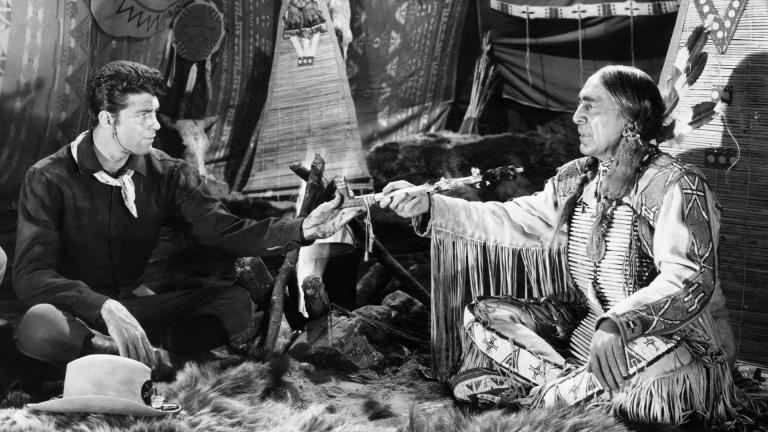
Read more about American History

Sitting Bull is arguably the most famous Native American in history. This chief of the Lakota tribe was a key figure in many battles fought between American Indians and the United States in the late 19th century.
Sitting Bull continues to capture the imagination as a symbol of resistance against oppression. He has been portrayed in many films, including the 1950 musical Annie Get Your Gun and 2017’s Woman Walks Ahead.
The lead star of Annie Get Your Gun was Betty Hutton as the real-life Wild West sharpshooter Annie Oakley. Meanwhile, J Carrol Naish co-starred as Sitting Bull — and reprised the role just a few years later for 1954’s Sitting Bull.
As its title suggests, this latter film gave Naish much more screen time. However, while Sitting Bull’s life heavily inspires it, many of the on-screen events diverge from the established history.
Below, we at Sky HISTORY answer several questions likely to play on your mind as you watch the Sitting Bull movie. (Spoilers for the film follow…)
Sitting Bull is especially well-known for leading Sioux forces at the Battle of Little Bighorn in June 1876. Here, a surprise attack by the US Army’s 7th Cavalry Regiment was foiled in spectacular style.
The lead character of the Sitting Bull movie is not strictly Sitting Bull himself but instead Robert Parrish, a member of the 7th Cavalry. The script follows Parrish (played by Dale Robertson) as he repeatedly declines to pursue and repress Native Americans, contrary to orders from his higher-ups.
Parrish is a completely fictitious character, albeit depicted as meeting a number of real-life historical figures. These include Sitting Bull as well as Lieutenant Colonel George Armstrong Custer, played by Douglas Kennedy. Custer commanded the 7th Cavalry at the Battle of Little Bighorn, which is also recreated on screen.
As Custer’s soldiers approached where the Sioux were camped near the Little Bighorn River, they were accompanied by members of the Native American Crow tribe.
These Crow agents warned Custer that the Sioux camp was much larger than he had anticipated. However, Custer was dismissive of their concerns — a factor now thought to have contributed to his army’s heavy defeat at the battle.
In the film, Custer is similarly warned in advance of the Sioux’s numerical advantage. However, in this instance, the warning comes from the fictitious Charles Wentworth (played by William Hopper), a war correspondent who joins Custer on the field.
Here, Wentworth actually relays a report from Parrish, now a captain. In response, Custer scoffs: 'Captain Parrish is notorious for his overestimate of all facts!'
In the film, Parrish finds Sitting Bull after his battlefield victory and warns him that another, much larger US army is on the way. After Parrish reveals that he knows how the tribe can escape to safety, he agrees to lead them there.
In real life, Sitting Bull and his people sought refuge in Canada shortly after the Battle of Little Bighorn. There is no evidence that any double-crossing American soldier helped them get there.
Nonetheless, Sitting Bull did go on to form a similarly friendly relationship with Canadian police superintendent James Walsh, who does not appear in the film.
After Parrish returns to home ground and admits what he has done, he is charged with treason and sentenced to death. However, just as Parrish is about to be shot by a firing squad, Sitting Bull arrives to rescue him.
In a highly melodramatic, Hollywood-ified scene, Sitting Bull pleads face-to-face with US President Ulysses S Grant to let Parrish go. Grant acquiesces, but there’s no historical record of the actual Grant ever meeting Sitting Bull in person.
Instead, the latter remained in Canada until 1881, when he finally surrendered to the United States. By that time, Grant had long left the White House, his presidential tenure having come to an end in 1877.
Sitting Bull did later meet another US commander-in-chief, President Grover Cleveland, during his first term (1885-1889).
It’s fair to say that many period dramas take liberties with historical facts. Still, watching these productions on TV and in the cinema can motivate you to research the actual recorded events.
Why not start by subscribing to the Sky HISTORY Newsletter? It’s a surefire way to ensure you are routinely emailed the latest updates about our upcoming documentaries.